Sébastien Jean-Marie SONNERY was arrested on 19th December 1943; he died 120 days later.
This page will contain as much detail as possible: his infernal journey from Chamelet to Flossenburg.
MONTLUC
Sébastien Jean-Marie SONNERY, the mayor of Chamelet, was arrested at 09:30 on Sunday, 19th December 1943 and conveyed directly to Montluc Prison, rue Jeanne Hachette in the 3rd arrondissement of Lyon.
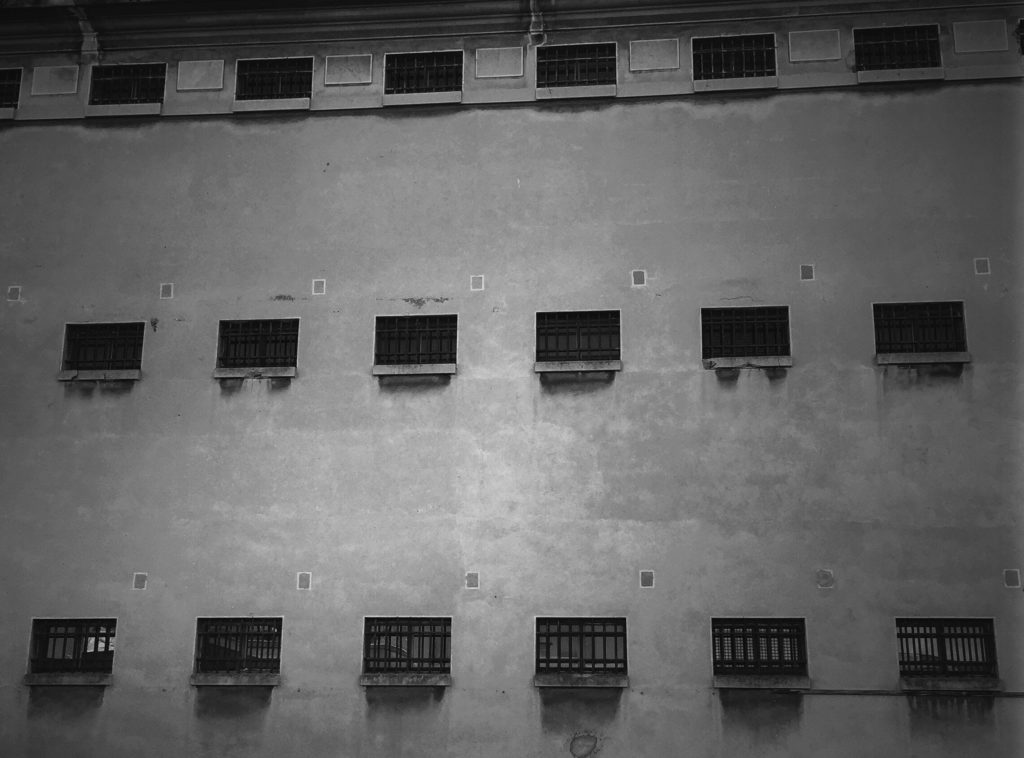
Brief History:
Montluc Prison, Lyon was built in 1921 as a military prison; after the armistice in 1940, the prison accommodated ordinary prisoners, soldiers and perpetrators of “anti-national activities”, essentially Gaullists and Communists. Following the invasion of Vichy France, in November 1942, the Germans requisitioned the prison and placed it under their exclusive control. Montluc then became the place for the internment of resistance fighters, hostages and victims of “racial measures”, awaiting their departure and deportation to the concentration and extermination camps.
The Gestapo also used Montluc as a prison and interrogation centre alongside the Gestapo headquarters on Avenue Bertholet, where interrogations took place on the premises of the army medical school. (The History of Resistance and Deportation Centre currently occupies the Avenue Bertholet address).
It is estimated that over 15,000 people were imprisoned in Montluc, and over 900 of them were executed within it.
Camp de Royallieu, Compiègne
Sébastien Jean-Marie SONNERY - Prisoner Number 22914

Brief History:
The Royallieu Camp, Compiègne, was originally a military barracks built in 1913 for the French army.
Serving briefly as a military hospital before the German Invasion in 1940, the German army used it as a POW camp for British and French Soldiers. In June 1941, the camp became “Frontstalag 122”, where the Wehrmacht detained political hostages comprising nationals of allied countries and Jews.
In the summer of 1942, the Gestapo took over the administration. Within the Royallieu camp was the notorious Camp C, the Jewish Camp, where thousands of victims of anti-Semitic persecution passed through their deportation.
Almost 50,000 resistance fighters, a,d political prisoners and hostages, just like Jean Marie SONNERY, were interned there and then deported to the Nazi death camps.
The Royallieu camp was the second largest antechamber of the death camps on French soil after Drancy.

After Sébastien Jean Marie SONNERY was interned at Montluc, he was transferred on 26 December 1943 to Compiègne (number 22914) – there is no precise information on the transfer conditions. There were several possible means – bus, train or lorry.
SONNERY managed to send a card to his wife, Alice, back in Chamelet. He told her he would be leaving soon but had no idea where.¹
SONNERY spent a total of twenty-three days at Compiègne; on 17 January, he was deported to Germany.
Buchenwald Concentration Camp
Sébastien Jean-Marie SONNERY - Prisoner Number 40055
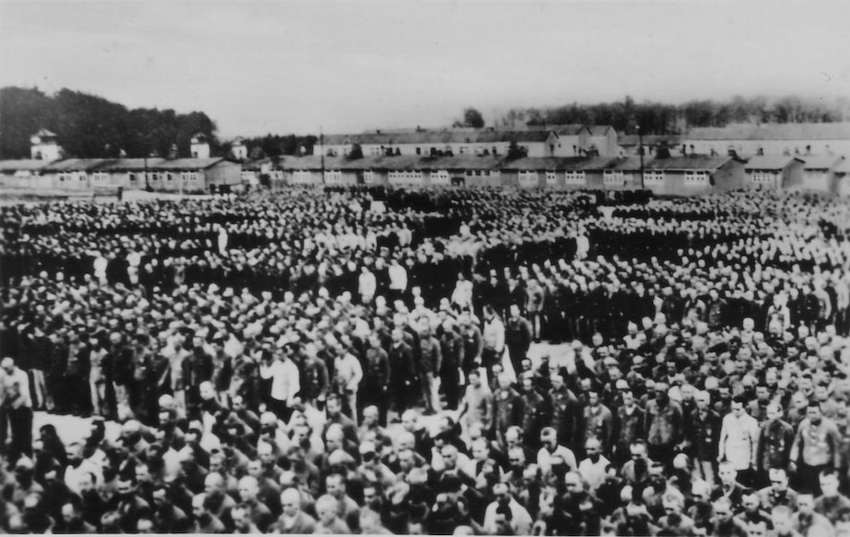
Sébastien Jean-Marie SONNERY left Compiègne on 17 January 1944 in a mass transport and arrived at Buchenwald 2 days later. Upon arrival, he was classified as a “Political Frenchman” prisoner number 40055 and placed in barrack 62 – known as the “little camp”.
He was later transferred to Barrack 56, a block allocated for disabled people.
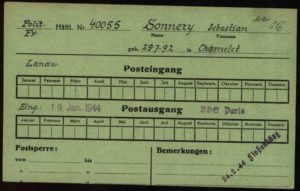
On 27 February 1944, Alice SONNERY received a letter from Jean-Marie; in his letter, he reassured her that all was well and asked her to send him some news.
Alice left a number of letters with the RED CROSS at Lyon. She does not know if these letters arrived. In fact, the Postal Card, shows that not only did Jean-Marie not receive any letters, but he did not send any either.
When SONNERY arrived at BUCHENWALD, he had only the clothes he was standing in and no other possessions.
A Hat, Coat, Jacket and trousers. He also wore a pullover with an Undershirt beneath it and underpants under his trousers. He wore socks and boots on his feet and had a wallet in his pocket that appeared empty.
Brief History:
Buchenwald was one of the first and the largest Nazi Concentration Camps within Germany’s 1937 borders near Weimar, Germany, in July of that year. Built initially to imprison opponents of the German Reich and other German citizens deemed to be undesirable, but in the eight years of its existence, around 240,000 inmates from 30 nationalities passed through the camp – it is estimated that approximately 56,000 out of them were killed or died from the harsh conditions.
In 1938, around 2,000 Jews were brought to Buchenwald from Austria, and following the Kristallnacht², in November 1938, another 10,000 German Jews were imprisoned in the camp. They were subjected to brutal terror. Six hundred of them perished; the others were released after they committed to leave Germany.
During the war years, the camp held many political prisoners, and at the time of Mayor SONNERY’s incarceration at the beginning of 1944, numbered around 63,000 souls.
When the camp was liberated on 11 April 1945, there were 21,000 survivors, including 4,000 Jews and 1,000 children. There are unsurprisingly no photographs of Monsieur SONNERY during his time at Buchenwald. However, in the 1990s, eleven photos surfaced showing life in and around the Little Camp, where SONNERY had been incarcerated. The photographs, taken by a man called Georges Angéli and now copyrighted to the Buchenwald Memorial, were taken shortly after SONNERY had been moved on to Flossenburg. The story of how those photographs came to be taken is a story of a courageous act of resistance by Monsieur Angéli, a young French man from Châtelleraudais who was arrested by the Gestapo while fleeing to Spain to escape the STO.
Monsieur Angéli was a photographer, and so, upon arrival at Buchenwald Concentration Camp was assigned to the Prisoner Photograph Department, which, from 1943, utilised the skills of individual foreign prisoners. Despite having minimal access to the cameras stored in the department, Monsieur Angéli managed to steal one in June 1944.
One Sunday, when there were no SS in the camp, he took the photos in and around the small camp.
You can view all of the photographs on fotoarchiv.buchenwald.de.
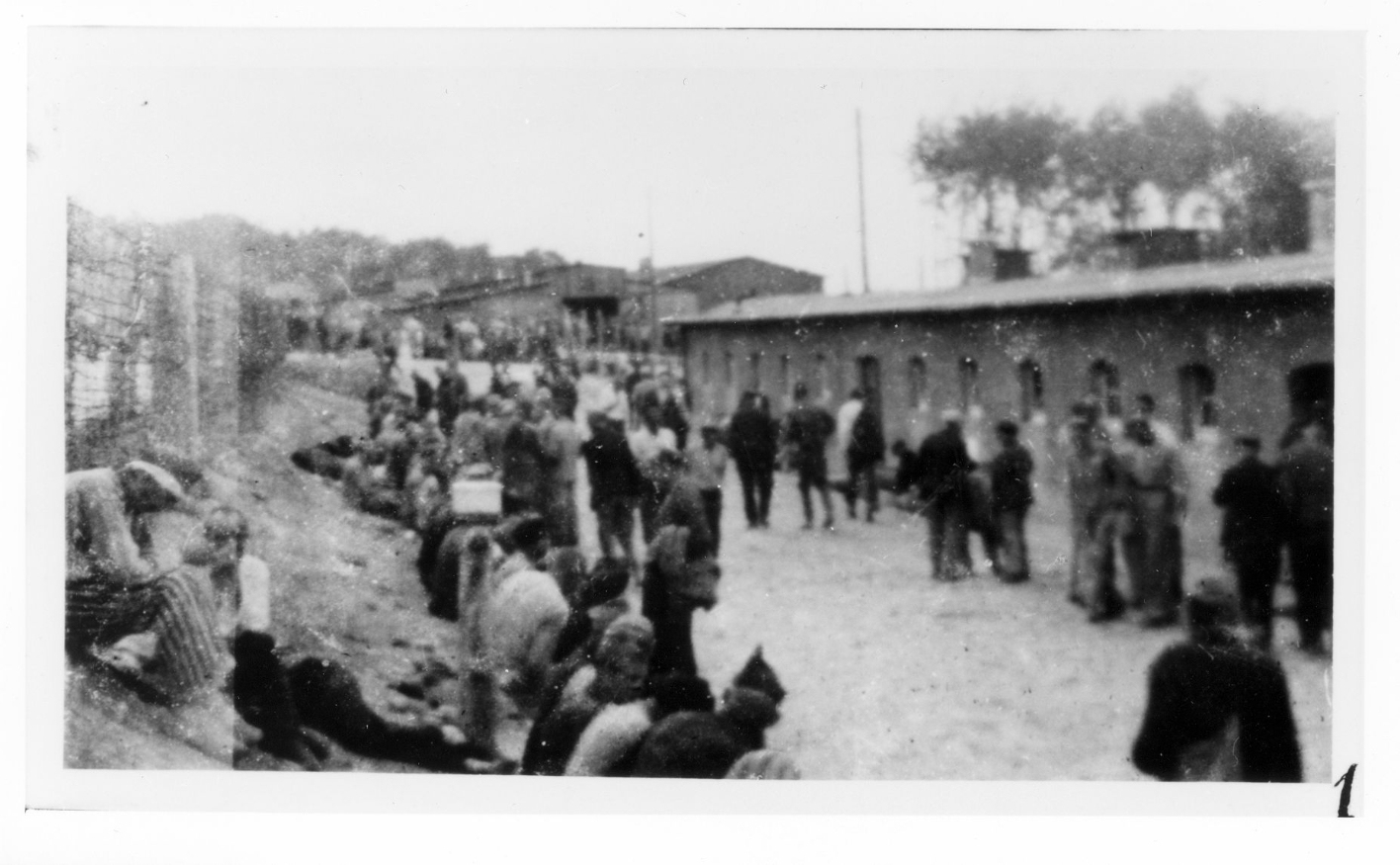
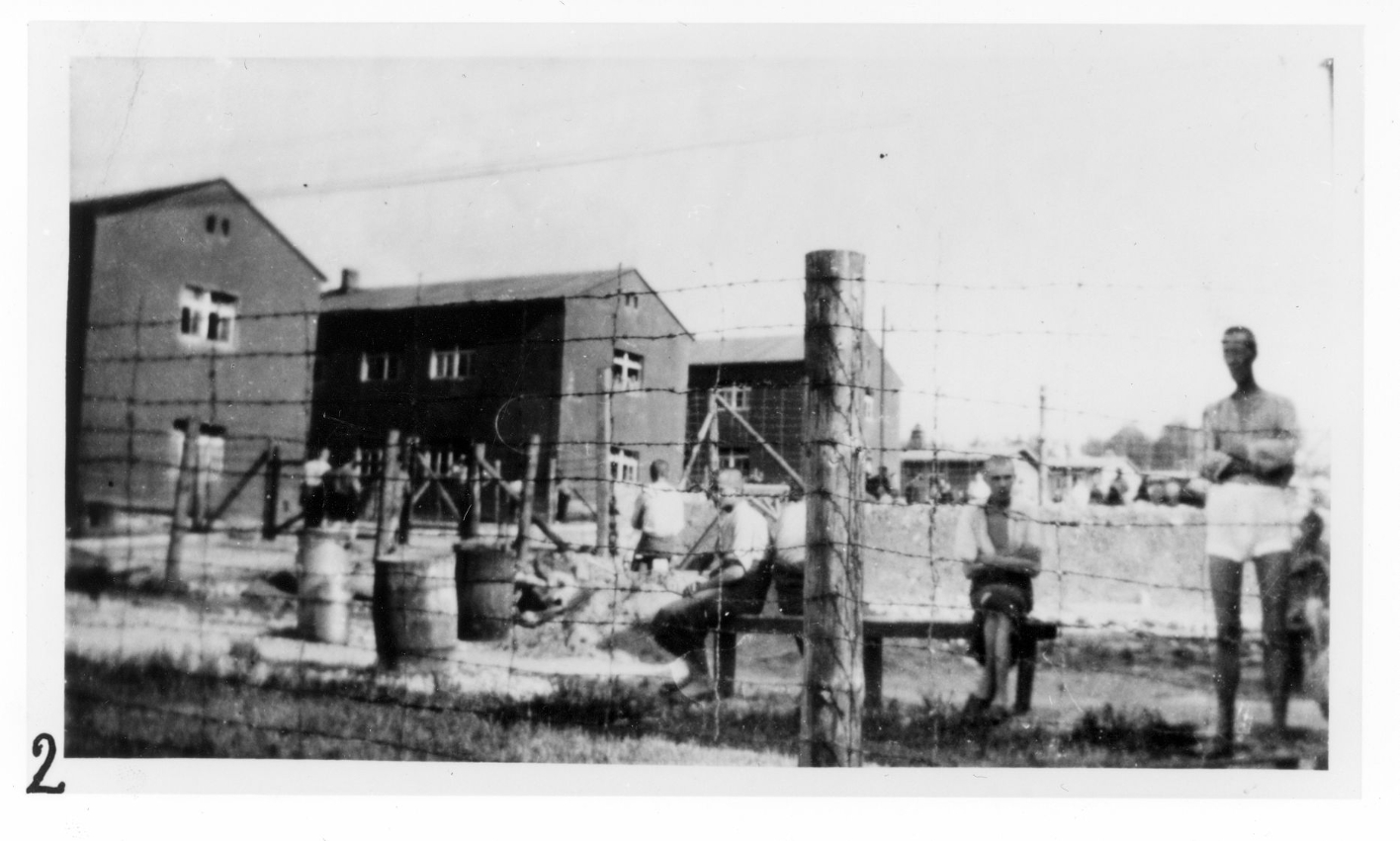
SONNERY’s move to Flossenburg was part of a mass transit. Some suggested that SONNERY was forced to march on foot to Flossenburg as the US forces approached the camp. This is not the case.
The Germans began to evacuate some 28,000 prisoners from the main camp in early April 1945. SONNERY left in February 1944. There are no official records of the deaths resulting from starvation, exposure, exhaustion, or murder by guards. However, it is estimated that between 15,000-25,000 perished.
Flossenbürg Concentration Camp
Sébastien Jean-Marie SONNERY - Prisoner Number 6814
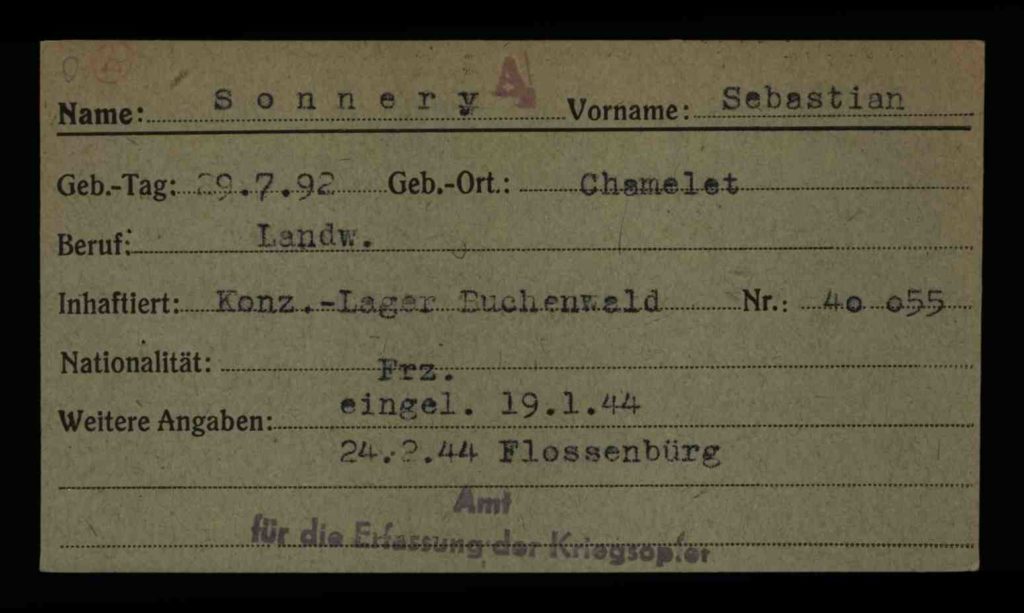
Brief History:
Flossenbürg was a Nazi concentration camp built in May 1938. It was located in a remote area in Bavaria.
The camps were built around several quarries to produce Granite for Nazi architecture.
However, the first quarry shut down in May 1943, and its workers were reassigned to arms production, but half of the prisoner labour was still working in the quarries.
The quarries caused the death rate to be higher at Flossenbürg than at camps with less physically demanding industries, but the switch to armaments production in 1943 did lead to a decrease in the death rate. Prisoners also suffered from a shortage of fresh water due to the elevation and unusually cold and wet weather; their clothing was inadequate for these conditions.
Initially constructed for only 1,500 prisoners, the population of the main camp increased to around 10,500 before it was evacuated in April 1945.
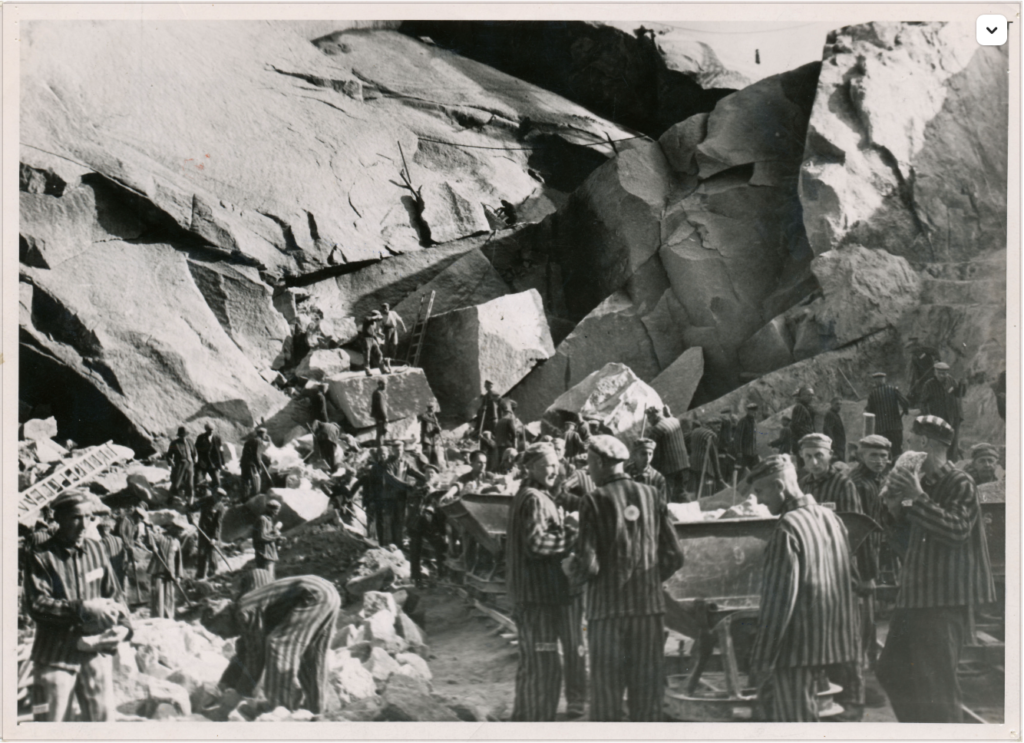
SONNERY was moved from BUCHENWALD, leaving on Tuesday, 22 February 1944, arriving at Flossenburg Concentration Camp the following day, and classed as a French Political with Prisoner number 6814.
His possessions were again checked: A Hat, Coat, Jacket and trousers, a pullover and undershirt, underwear, socks and boots on his feet and his empty wallet.
File Card - Prisoner 6814 SONNERY
File Card
This is the file card for Prisoner 6814 SONNERY. It is a record of all the documentation that relates explicitly to him. In this case, just two items:
An effektenkarte and a sterbeurkunde.
That is; his list of possessions that amounted to just the clothes he was wearing and his death certificate.
In her statement to the Gendarmes working on behalf of the Department for Research on Enemy War Criminals, Alice SONNERY stated that she received a second letter from Jean Marie in March 1944 when he was at Flossenburg, just like in his first letter, he stated that his morale was good and asked her to send parcels.
Effects Card - Prisoner 6814 SONNERY
Effects Card
This is the EFFECTS CARD for Prisoner 6814 SONNERY. It records all the details known about SONNERY and was recorded by the Prison Camp Guards. It contains the details of his Next of Kin and a list of his personal possessions – the clothes he wore – A Hat, Coat, Jacket and trousers, a pullover and undershirt, underwear, socks and boots on his feet and his empty wallet.
In addition, it contains an ink stamp:
Versterben am 17.APR.1944
Died on 17 April 1944; this corroborates the date provided on the death certificate.
The Death of Sébastien Jean-Marie SONNERY - Prisoner Number 6814
Sébastien Jean-Marie SONNERY has no grave. His body was cremated, and Asche im Umfeld des Krematoriums, Konzentrationslager Flossenbürg – His ashes were transferred to ash pits around the crematorium at Flossenburg.
The primary record relating to his death can be found in the Prisoner Record Book, which would have been completed at or around the time of his death.
Flossenburg Prisoner Record Book

The prisoner record book clearly shows his date of death as 18 April 1944. However, in addition to the stamp detailed above on the Prisoner Effects Card, the date of death of the day before – 17 April 1944 – shows up on the death certificate that the camp’s physicians completed.
According to Annabelle Lienhart, M.A. of the Flossenburg Historical Department. “The causes of death reported in the death certificates of the camp’s physicians did not usually correspond to the actual causes of death.” Since the cause of death was regarded as arbitrary, it is not beyond the realms of possibility that the same can be said for the date of death, too.
Death Certificate of Sébastien Jean-Marie SONNERY
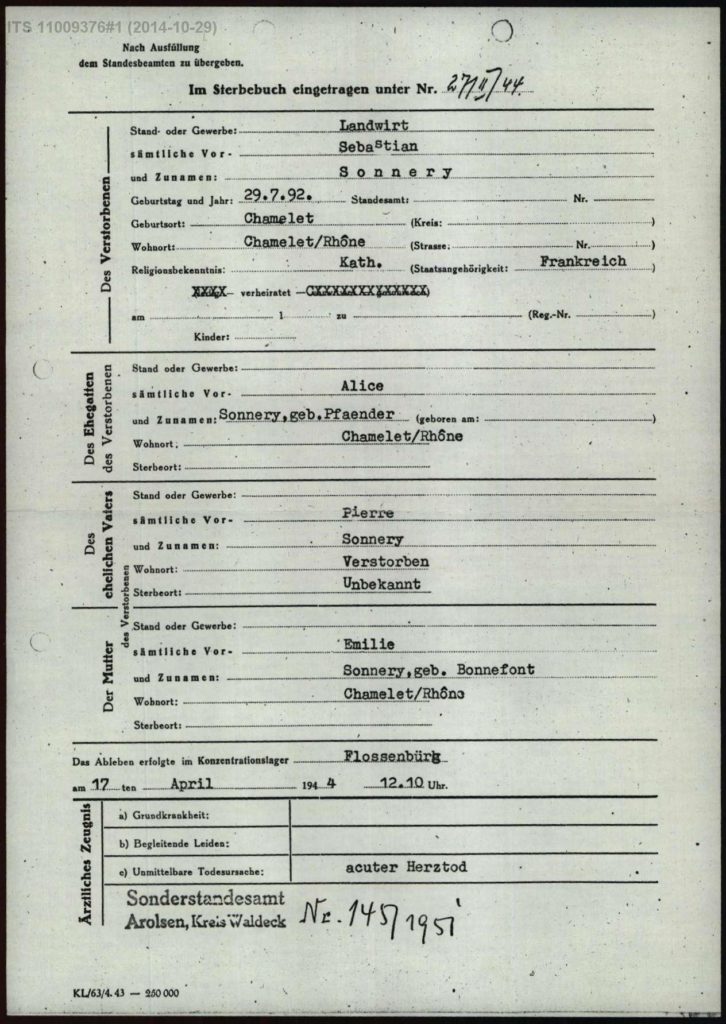
The death certificate shows the cause of death as Acuter Herztod – acute cardiac death whilst other records offer a more generic, physical breakdown or illness. However, according to Annabelle Lienhart, M.A., what is sure is that SS guards or Kapos often arbitrarily murdered prisoners.
When the US 3rd Army liberated Flossenburg, they began a massive task of identifying the living and the dead. SONNERY appears twice in the records that were made—the first shows on page 184. Sebatien Sonnery, prisoner number 6814, French, born 29 July 82, arrived on 23 February 44 and died on 17 April 44.
On the second sheet, his name is correctly spelt along with French and Prisoner number, showing the date of death as 18.4.44.
The final document – a resume of some of the murdered French Citizens shows the 17 April date.
In May 1947, all the ashes from the ash pit were collected and made into a large pyramid at the “Valley of Death” of the Flossenburg Concentration Camp Memorial.
Valley of death - memorial in the former concentration camp Flossenbürg. Ash pyramid. Crematorium in the background

SOURCES
RESOURCES:
Header Photo Source: Google Maps.
Photo Mémorial National de la Prison de Montluc ©Martin Baker Feb 2019
Montluc History Source : Ministère des Armées, Secrétariat général pour l’administration, Direction des patrimoines, de la mémoire et des archives
Montluc Documentation and Map : Les Archives du département du Rhône et de la métropole de Lyon 3335W25 – Personnes internées dans la prison Montluc… SONNERY Sébastien (dit JEAN-MARIE) Producteur :Service régional de police judiciaire de Lyon (SRPJ)
Photos Camp de Royallieu, Compiègne : Source : ©Martin Baker July 2022
Photo “Arrivée d’un convoi au camp de Royallieu” Source : ©CDJC / Ministére des Anciens Combattants et Victimes de Guerre.
¹ : Statement of Madame Alice Adèle PFAENDER-SONNERY 51 years – Farmer and wife of the Mayor of Chamelet. 13h00 16 January 1945 by Claudius FARGE and Raymond VILDIEU, Gendarmes in residence Le Bois d’Oinght Rhône.
Photo Buchenwald concentration camp near Weimar. 1944 prisoners during Roll Call. No. 7 Source : Buchenwald Memorial
Buchenwald Concentration Camp history : Buchenwald concentration camp. (2023, September 22). In Wikipedia. https://en.wikipedia.org/wiki/Buchenwald_concentration_camp and https://www.yadvashem.org/righteous/stories/buchenwald-historical-background.html
Photo Rock Breaking Flossenburg 1942 – NIOD Institut für Kriegs-, Holocaust- und Genozidforschung, Amsterdam
Note of Process Verbal, Chamelet 17 July 1943 – Source Archives Conseil Municipal Maire de Chamelet
Database: “Flossenbürg Documentation of the 3rd U.S. Army” (Schema “Flossenbürg-Dokumentation der 3. US-Armee”)
Photo of Valley of death – memorial in the former concentration camp Flossenbürg. Ash pyramid. Crematorium in the background SOURCE: Author Kritzolina Creative Commons.
NOTES:
International Centre on Nazi Persecution.
In 1943, the international section of the British Red Cross was asked by the Headquarters of the Allied Forces to set up a registration and tracing service for missing people. Initially named the Central Tracing Bureau on February 15, 1944, and was eventually located in Bad Arolsen, Germany. It was considered a central location among the areas of Allied occupation and had an intact infrastructure unaffected by the war.
It is now named The Arolsen Archives – International Center on Nazi Persecution (Service International de Recherches), an internationally governed centre for documentation, information and research on Nazi persecution, forced labour and the Holocaust in Nazi Germany and its occupied regions. The archive contains about 30 million documents from concentration camps, details of forced labour, and files on displaced persons.
It preserves the original documents and clarifies the fate of those persecuted by the Nazis.
Much of the documentation sourced directly from the various camps on this page is also available online at https://arolsen-archives.org/
² Kristallnacht or the Night of Broken Glass, also called the November pogrom, was a pogrom against Jews carried out by the Nazi Party’s Sturmabteilung paramilitary and Schutzstaffel paramilitary forces
(Last Edited: Oct 18, 2019
Author(s): United States Holocaust Memorial Museum, Washington, DC
ACKNOWLEDGEMENTS:
With thanks to : Research Staff at Mémorial National Prison de Montluc, 4 rue Jeanne Hachette, 69487, Lyon
With thanks to : Julia MAITRE, Assistante à la régie des collections, Mémorial de l’internement et de la déportation, Camp de Royallieu, Compiègne.
With thanks to : Anita Ganzenmüller, Buchenwald and Mittelbau-Dora Memorials Foundation, Buchenwald, 99427 Weimar, Germany
With thanks to : Annabelle Lienhart, M.A. Département historique des employés, Mémorial du camp de concentration de Flossenbürg, Allée du Souvenir 5, D-92696 Flossenbürg.
With thanks back in 2019 to : Ms Floriane Bourrelly, a student at ISCOM, for her assistance in understanding the German documents used in this investigation.
This post is also available in:
 Français
Français
